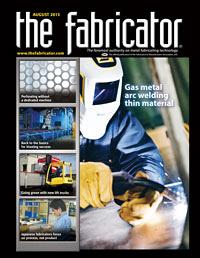Senior Editor
- FMA
- The Fabricator
- FABTECH
- Canadian Metalworking
Categories
- Additive Manufacturing
- Aluminum Welding
- Arc Welding
- Assembly and Joining
- Automation and Robotics
- Bending and Forming
- Consumables
- Cutting and Weld Prep
- Electric Vehicles
- En Español
- Finishing
- Hydroforming
- Laser Cutting
- Laser Welding
- Machining
- Manufacturing Software
- Materials Handling
- Metals/Materials
- Oxyfuel Cutting
- Plasma Cutting
- Power Tools
- Punching and Other Holemaking
- Roll Forming
- Safety
- Sawing
- Shearing
- Shop Management
- Testing and Measuring
- Tube and Pipe Fabrication
- Tube and Pipe Production
- Waterjet Cutting
Industry Directory
Webcasts
Podcasts
FAB 40
Advertise
Subscribe
Account Login
Search
Complete work instructions keystone of improvement
How can you improve what you have if you don’t know what you’ve got?
- By Tim Heston
- August 9, 2013
- Article
- Shop Management
Let’s face it, no one’s child says this: “When I grow up, I want to spend my days reading job travelers with detailed work instructions, then meet with my co-workers to suggest improvements and implement them, yet always being sure to document such improvements so that everyone in the organization is on the same page.”
Translated to normal speech, this means, “I want to spend my days being creative and following directions.” That’s not a natural tendency, but it’s one that has become extremely valued in manufacturing. And it all starts with standard work instructions.
Work instructions and process documentation are key tenets of continuous improvement. How can you improve something if you don’t know exactly what it is you’re improving upon?
In June, Dave Lechleitner of Bloomington, Minn.-based Exact Software presented in Columbus, Ohio, at LeanFab, a workshop organized by the Fabricators & Manufacturers Association that is dedicated to continuous improvement in metal fabrication. He talked of the importance of complete, detailed work instructions. Developing them is never a straightforward affair, and they can be even more complex in high-product-mix, low-volume environments.
Here, Lechleitner pointed to something that has become a common improvement thread in job shops: Identify the repeatedly ordered items and part families with similar part attributes. During the session he showed work instructions from a job shop that had standard steps for the product family in regular type. Steps unique to the part number were in all capital letters and highlighted. In red at the top right was the quantity ordered, and workers were instructed to never run more than necessary to save on setup (a bad habit the shop was trying to break).
He also described how scrutinizing those work instructions leads directly to improvement. One company actually asked its janitor to read the instructions and set up a machine. Managers at first used the exercise simply to ensure the instructions were detailed enough so that anyone at the shop could follow them. But they soon discovered that not only was the janitor asking for clarification on certain steps, he also asked why steps were performed that way in the first place. They took his input, eliminated some unnecessary steps, and improved the process.
Lechleitner asked conference attendees about part prints: “What’s the danger in letting an employee work off just the part print?”
“You’re letting that person interpret what the customer really wants,” one attendee answered.
As Lechleitner explained, “The work instructions translate for everyone who needs to be involved what your expectations are as well as what the customer expectations are.”
Central to that expectation, he said, is the time standard, which identifies how long specific tasks should take. Time standards can act as a benchmark for improvement ideas, be it in staff meetings or during formal kaizen events.
Not everyone at the workshop agreed on this point. Are time standards really relevant in a high-mix, low-volume shop, where every order is different? Some argued that standard operations for part families—those parts with similar geometries and manufacturing requirements—can benefit from time standards specified on work instructions. Others said that it could be “just another number,” perhaps created by a person unfamiliar with certain shop floor operations. The result: The time standards are simply ignored.
All agreed that time standards can be a great improvement tool if a shop has procedures in place for (and a culture that fosters) continual worker feedback. The feedback not only can be about the time standard, but also steps to improve overall operations. Can you errorproof assembly? Can a few bends replace welding? Is there a reason that the flat-part deburring machine is so far away from the punch press and laser? Why aren’t certain tools or materials labeled?
These questions sound like a good jump-start for an improvement initiative. But as attendees at LeanFab discussed, the current state must be measured and documented, and the work instructions provide that documentation. And for shops continually improving, those documents are continually changing. That’s why some shops are even moving away from paper travelers and going all digital, with tablets or computer stations on the shop floor being updated immediately—no more lost travelers, no more old revisions lying around the shop.
Be they paper or digital, the idea of standard work instructions still brings up a cultural conundrum, and it may be one reason that finding skilled labor remains a challenge. Traditionally, the more a person learns about a process, the better that person becomes and the more valuable that person is to employers. This still is often the case. Every shop seems to have its technical gurus, especially in bending and welding. But at many companies, I’m seeing success built upon not just technical expertise, but also new ideas. It’s not just about a person’s knowledge, but also how well that knowledge is spread and improved upon, either by the technical guru himself or by others in the organization.
The technical guru and the great communicator sometimes aren’t the same person, and sometimes a shop employs both to thrive. Fabricators like DeWys Manufacturing outside Grand Rapids, Mich., and Schuette Metals in Rothschild, Wis., know this well. They have extensive in-house training programs, and they tap certain individuals as good educators, but they may not be the absolute best at a certain trade. Nevertheless, they can communicate well to new recruits and spread the knowledge.
The two brutal recessions that started the 21st century proved that improvement is a necessity for survival. A person with decades of experience behind a press brake is extremely valuable to his employer, but if his knowledge isn’t documented, shared, and used for improvement, the company may not survive.
This comes back to documentation. Shops start improving by measuring and documenting what they already do, because they can’t improve what they don’t measure. As Lechleitner explained, a central tenet of all this is the standard work instruction.
About the Author

Tim Heston
2135 Point Blvd
Elgin, IL 60123
815-381-1314
Tim Heston, The Fabricator's senior editor, has covered the metal fabrication industry since 1998, starting his career at the American Welding Society's Welding Journal. Since then he has covered the full range of metal fabrication processes, from stamping, bending, and cutting to grinding and polishing. He joined The Fabricator's staff in October 2007.
Related Companies
subscribe now

The Fabricator is North America's leading magazine for the metal forming and fabricating industry. The magazine delivers the news, technical articles, and case histories that enable fabricators to do their jobs more efficiently. The Fabricator has served the industry since 1970.
start your free subscription- Stay connected from anywhere

Easily access valuable industry resources now with full access to the digital edition of The Fabricator.

Easily access valuable industry resources now with full access to the digital edition of The Welder.

Easily access valuable industry resources now with full access to the digital edition of The Tube and Pipe Journal.
- Podcasting
- Podcast:
- The Fabricator Podcast
- Published:
- 04/16/2024
- Running Time:
- 63:29
In this episode of The Fabricator Podcast, Caleb Chamberlain, co-founder and CEO of OSH Cut, discusses his company’s...
- Industry Events
16th Annual Safety Conference
- April 30 - May 1, 2024
- Elgin,
Pipe and Tube Conference
- May 21 - 22, 2024
- Omaha, NE
World-Class Roll Forming Workshop
- June 5 - 6, 2024
- Louisville, KY
Advanced Laser Application Workshop
- June 25 - 27, 2024
- Novi, MI
































